|
|

© copyright 2003 Michael P.
Hamilton, Ph.D.
Fire-Scope
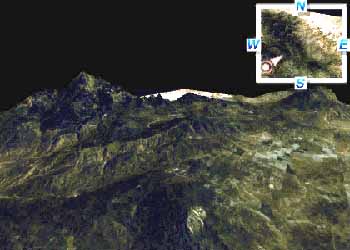
July 1, 1996:
Sitting safely on top of the giant boulders near Black
Mountain,
I rotated the trackball of my laptop computer to electronically
move an
imaginary mountain range. Suddenly the outline of
computer generated
peaks, ridge lines and valleys began to resemble the
very same panorama
I was experiencing from my mountain top lookout, with
a single
significant exception, the real landscape I was viewing
was on fire!

downtown Idyllwild on the day the town was evacuated
Earlier today I packed up my computers and family
photographs and locked the doors of my home in Idyllwild
to
head for the James Reserve. I know I was supposed
to leave the Hill,
most of you did, but I had much work to do to prepare
the Reserve
facilities for the chance that the Bee fire might
be heading that way.
Upon arrival the first order of business was to set
up the computers
and install the Forest Stewardship Database. Years
in the making, this
computerized geographic library of the entire San
Jacinto Mountains
contained detailed maps of natural vegetation, fuel
types, topography,
wind movements, and land uses. Best of all, it gives
us the means to understand
the spread of fire under different weather conditions.
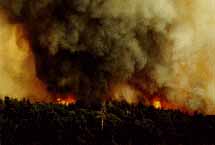
fireline approaching Pine Cove
After installing files into my portable Powerbook
computer,
and entering the most recent Forest Service fire perimeter
data
that Pat Boss had provided on my way out of town,
I hiked up to
the highest point near the Reserve where I could gain
a vantage
point of the fire. With binoculars I could clearly
watch ground level
firefighters perched along the slopes of Indian Mountain.
Flames
were visible to me along the northwest ridge line
of Indian Mountain,
and one air tanker after another was bombarding the
wild fire with the
bright pink fire retardant. The pilots were incredible
in their mastery
of the art of dropping their load of retardant precisely
upon the
vegetation that was just beginning to burn. From where
I was sitting I
could estimate that the line of fire was less than
two miles away
and burning in this direction!
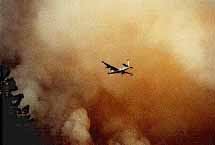
bombers slinging fire retardant
Activating the Forest Stewardship Database software,
I queried the
topographic map index for the portion containing Indian
Mountain.
Viewable with a three dimensional perspective, I interactively
twisted
and zoomed into the colorful shaded relief map until
the computer
display approximated the same view I could see through
my binoculars.
Over the years my students and I have constructed
dozens of computerized
maps after carefully studying satellite and aerial
images, maps that can be
precisely superimposed upon the realistic 3-D model.
I called up a map of
historic fire boundaries which superimposed itself
onto the digital view
of Indian Mountain. The fire line that I now watched
burning in the northward
direction was attempting to ignite vegetation that
had last
burned in the 1974 Soboba Fire.
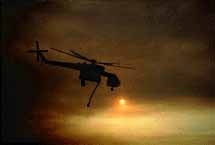
helicopter water tanker over a smokey sunset
My "fire-scope" showed that the flames were
moving towards
a moist drainage, and it would have to burn against
the prevailing
wind to accelerate. Another digital map portraying
overall fire
hazard severity suggested that the fire would dramatically
diminish in rate of spread and intensity as it attempts
to consume
the vegetation between there and here.
The real danger, of course, was with the south and
west moving flanks
of the fire. It was apparent that the fire was burning
rapidly into the
North Fork drainage and could leap across the canyon
to make a run
up towards Logan Creek and the northwest side of Pine
Cove.
By merging fire hazard maps and property boundaries,
I identified
numerous critical points where the fire line could
threaten homes.
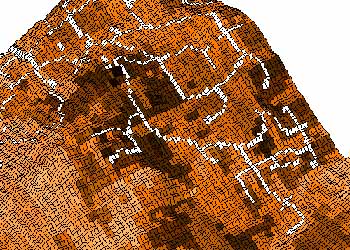
fire hazard data layer for a section of Pine Cove. with darker
colors
indicating higher levels of flammable fuels
Knowledge is said to be power, but what is the power
of knowing
what might happen, yet not be able to do a thing about
it.
Fortunately the fate of our mountain communities was
in the very
capable hands of expert fire fighters. That night,
the fire that was threatening
the James Reserve was put out, and the remaining fires
moved closer and
closer to Pine Cove and Idyllwild Arts.
What happened next, well, that is already old news!

previous journal entries
|

